Abstract
In order to know the phylogenetic relationship and the route of transmission of a variant of coxsackievirus A24 (CA24v), an agent that caused four sequential outbreaks of acute hemorrhagic conjunctivitis from 1985 to 1989 in Taiwan, the nucleotide sequence variations in the virus-encoded proteinase 3C region (549 nucleotides) were studied with 19 isolates. The prototype strain (EH24/70), four isolates from Japan, and two isolates from Hong Kong were used for comparison. The nucleotide sequences of the Taiwan strains from the 1985-1986 and 1988-1989 epidemics were closely related within each epidemic, while they were more distantly related between strains from two epidemics. Phylogenetic analysis by the unweighted pairwise grouping method of the arithmetic average revealed that the 19 Taiwan isolates had diverged into two groups, 1985-1986 and 1988-1989 groups. The time at which these two groups diverged was estimated to be around May 1982, more than 3 years prior to the first appearance of the CA24v epidemic in Taiwan. On each occasion, the viruses caused a 2-year epidemic and then disappeared. The Taiwan isolates from 1985 to 1986 were closely related to the Japan isolates from 1985 to 1986 and the Taiwan isolates from 1988 to 1989 were phylogenetically close to the 1989 Japan isolates, indicating that Taiwan and Japan had two common-source outbreaks. However, none of the 1988 Taiwan isolates were phylogenetically close to the 1988 Japan or Hong Kong isolates. The evidence revealed that Taiwan has had two repeated but discontinuous introductions of CA24v since its first appearance in Taiwan in 1985. None of the other CA24v strains have been detected so far.
Full text
PDF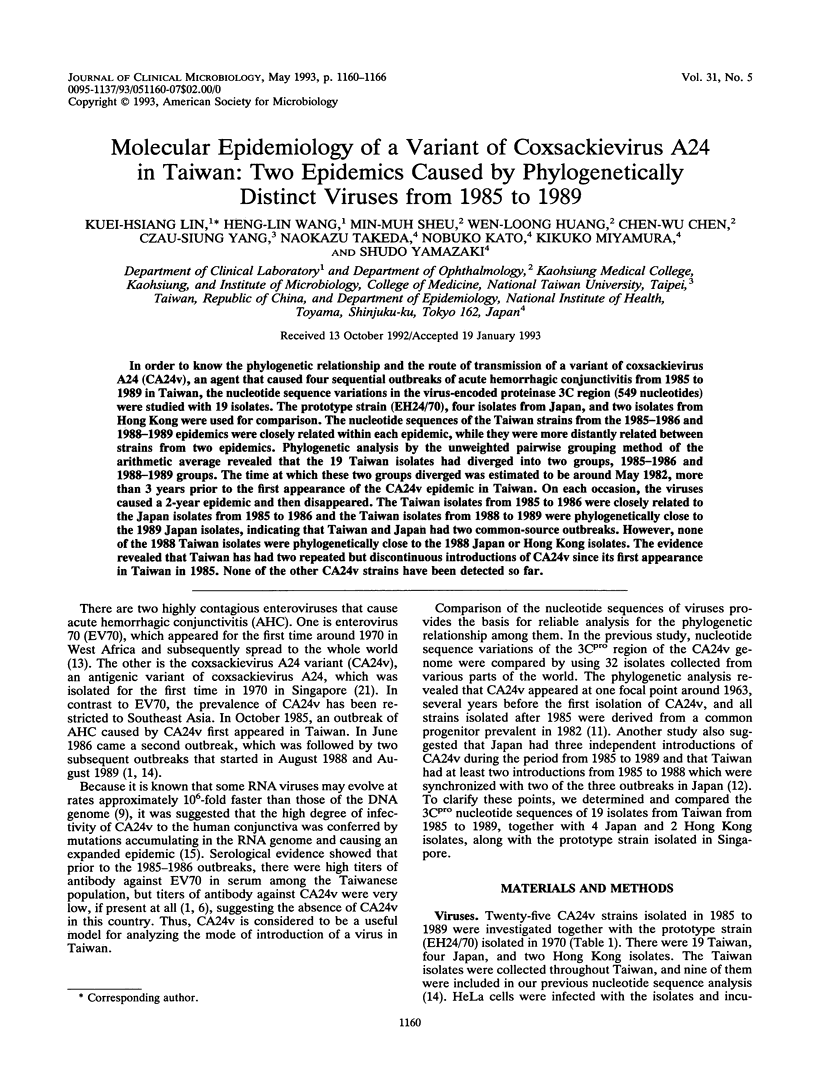
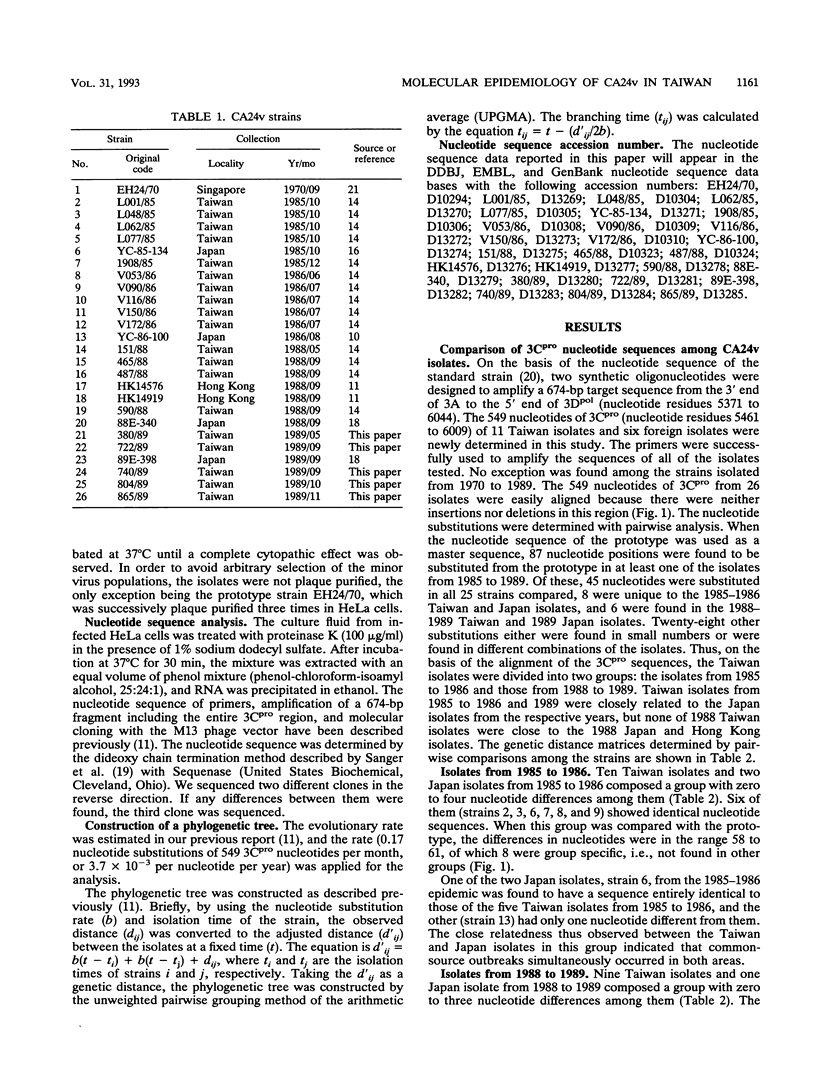

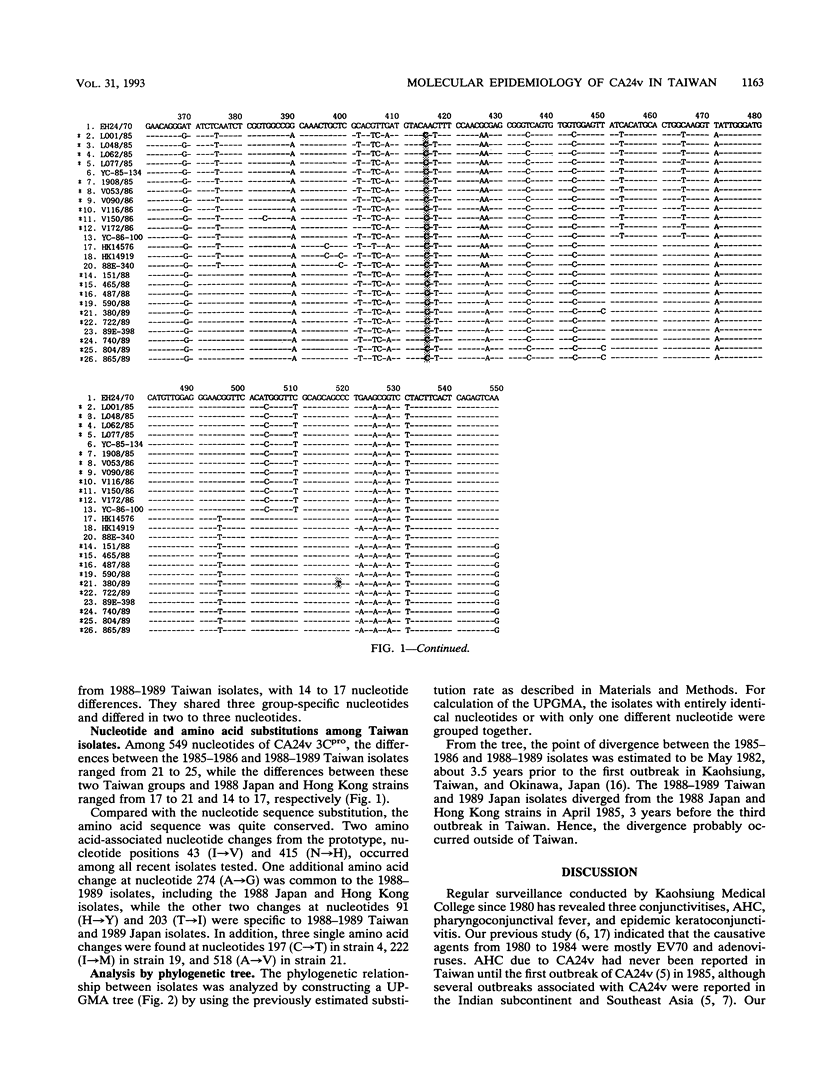
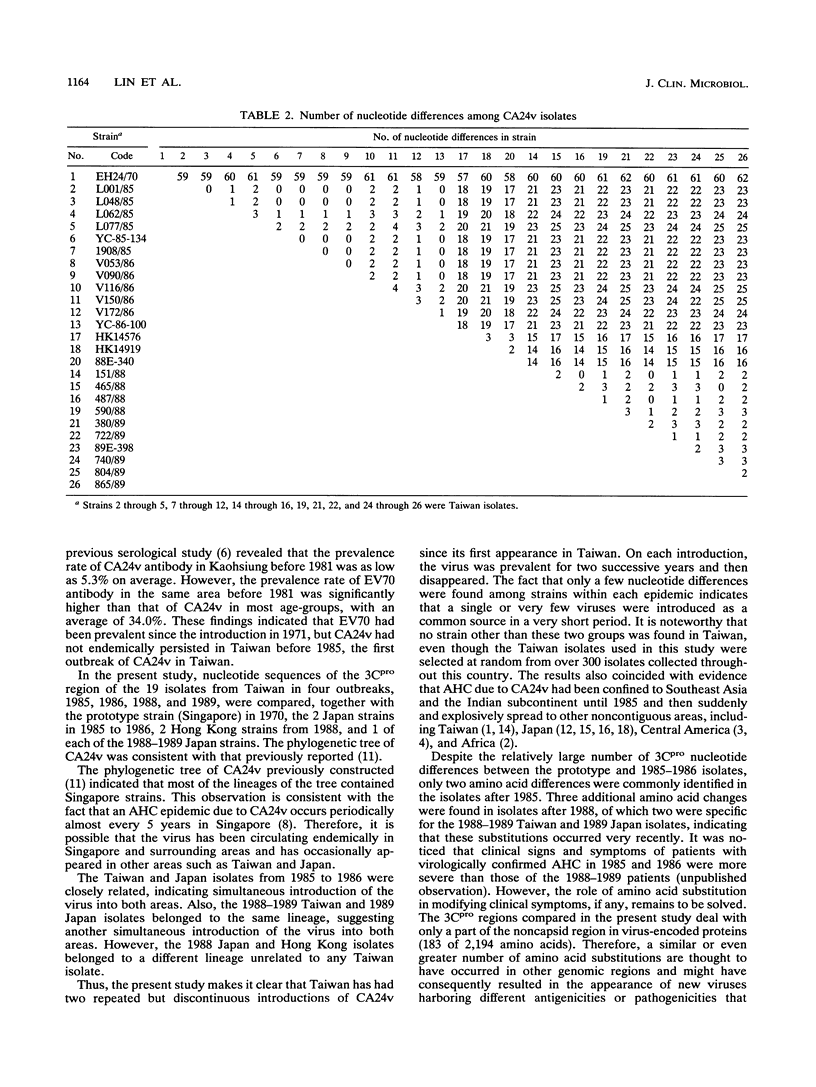
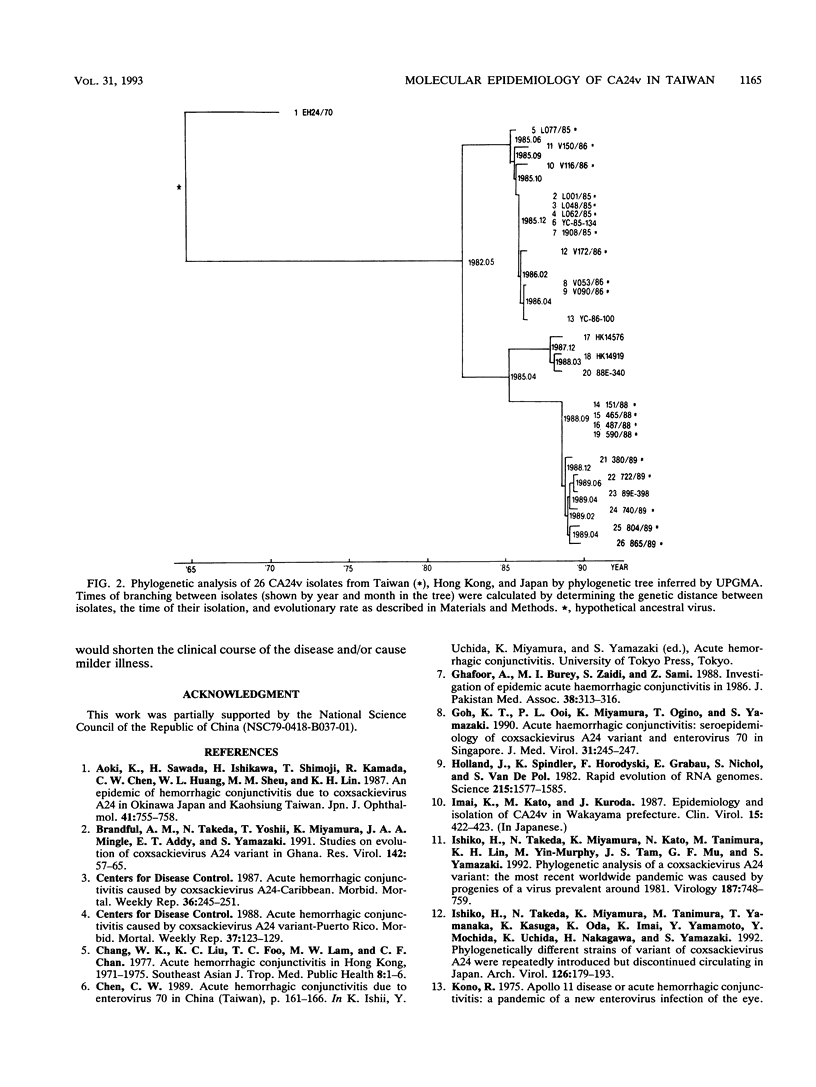
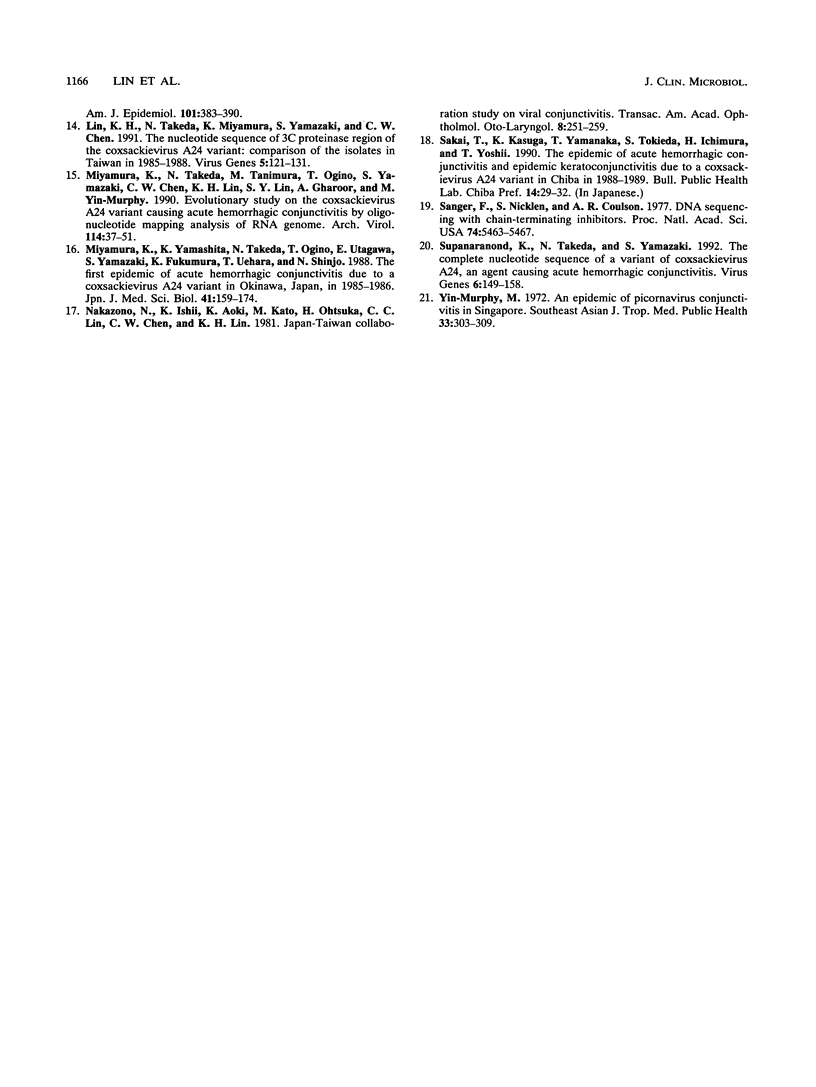
Selected References
These references are in PubMed. This may not be the complete list of references from this article.
- Brandful J. A., Takeda N., Yoshii T., Miyamura K., Mingle J. A., Addy E. T., Yamazaki S. A study of the evolution of coxsackievirus A24 variant in Ghana by viral RNA fingerprinting analysis. Res Virol. 1991 Jan-Feb;142(1):57–65. doi: 10.1016/0923-2516(91)90028-2. [DOI] [PubMed] [Google Scholar]
- Chang W. K., Liu K. C., Foo T. C., Lam M. W., Chan C. F. Acute haemorrhagic conjunctivitis in Hong Kong 1971-1975. Southeast Asian J Trop Med Public Health. 1977 Mar;8(1):1–6. [PubMed] [Google Scholar]
- Ghafoor A., Burney M. I., Zaidi S., Sami Z. Investigation of epidemic acute haemorrhagic conjunctivitis in 1986. J Pak Med Assoc. 1988 Dec;38(12):313–316. [PubMed] [Google Scholar]
- Goh K. T., Ooi P. L., Miyamura K., Ogino T., Yamazaki S. Acute haemorrhagic conjunctivitis: seroepidemiology of coxsackievirus A24 variant and enterovirus 70 in Singapore. J Med Virol. 1990 Jul;31(3):245–247. doi: 10.1002/jmv.1890310313. [DOI] [PubMed] [Google Scholar]
- Holland J., Spindler K., Horodyski F., Grabau E., Nichol S., VandePol S. Rapid evolution of RNA genomes. Science. 1982 Mar 26;215(4540):1577–1585. doi: 10.1126/science.7041255. [DOI] [PubMed] [Google Scholar]
- Ishiko H., Takeda N., Miyamura K., Kato N., Tanimura M., Lin K. H., Yin-Murphy M., Tam J. S., Mu G. F., Yamazaki S. Phylogenetic analysis of a coxsackievirus A24 variant: the most recent worldwide pandemic was caused by progenies of a virus prevalent around 1981. Virology. 1992 Apr;187(2):748–759. doi: 10.1016/0042-6822(92)90477-7. [DOI] [PubMed] [Google Scholar]
- Ishiko H., Takeda N., Miyamura K., Tanimura M., Yamanaka T., Kasuga K., Oda K., Imai K., Yamamoto Y., Mochida Y. Phylogenetically different strains of a variant of coxsackievirus A 24 were repeatedly introduced but discontinued circulating in Japan. Arch Virol. 1992;126(1-4):179–193. doi: 10.1007/BF01309694. [DOI] [PubMed] [Google Scholar]
- Lin K. H., Takeda N., Miyamura K., Yamazaki S., Chen C. W. The nucleotide sequence of 3C proteinase region of the coxsackievirus A24 variant: comparison of the isolates in Taiwan in 1985-1988. Virus Genes. 1991 Apr;5(2):121–131. doi: 10.1007/BF00571927. [DOI] [PubMed] [Google Scholar]
- Miyamura K., Takeda N., Tanimura M., Ogino T., Yamazaki S., Chen C. W., Lin K. H., Lin S. Y., Ghafoor A., Yin-Murphy M. Evolutionary study on the Coxsackievirus A 24 variant causing acute hemorrhagic conjunctivitis by oligonucleotide mapping analysis of RNA genome. Arch Virol. 1990;114(1-2):37–51. doi: 10.1007/BF01311010. [DOI] [PubMed] [Google Scholar]
- Miyamura K., Yamashita K., Takeda N., Ogino T., Utagawa E., Yamazaki S., Fukumura K., Uehara T., Shinjo N. The first epidemic of acute hemorrhagic conjunctivitis due to a coxsackievirus A24 variant in Okinawa, Japan, in 1985-1986. Jpn J Med Sci Biol. 1988 Aug;41(4):159–174. doi: 10.7883/yoken1952.41.159. [DOI] [PubMed] [Google Scholar]
- Sanger F., Nicklen S., Coulson A. R. DNA sequencing with chain-terminating inhibitors. Proc Natl Acad Sci U S A. 1977 Dec;74(12):5463–5467. doi: 10.1073/pnas.74.12.5463. [DOI] [PMC free article] [PubMed] [Google Scholar]
- Supanaranond K., Takeda N., Yamazaki S. The complete nucleotide sequence of a variant of Coxsackievirus A24, an agent causing acute hemorrhagic conjunctivitis. Virus Genes. 1992 Apr;6(2):149–158. doi: 10.1007/BF01703064. [DOI] [PubMed] [Google Scholar]
- Yin-Murphy M. An epidemic of picornavirus conjunctivitis in Singapore. Southeast Asian J Trop Med Public Health. 1972 Sep;3(3):303–309. [PubMed] [Google Scholar]


